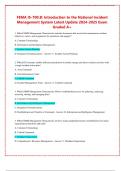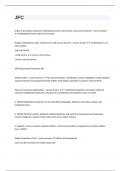FEMA IS-700.B: Introduction to the National Incident
Management System Latest Update 2024-2025 Exam
Graded A+
1. Which NIMS Management Characteristic includes documents that record and communicate incident
objectives, tactics, and assignments for operations and support?
A. Common Terminology
B. Information and Intelligence Management
C. Incident Action Planning
D. Integrated Communications - Answer- C. Incident Action Planning
2. Which ICS structure enables different jurisdictions to jointly manage and direct incident activities with
a single incident action plan?
A. Area Command
B. Joint Information Center
C. Unified Command
D. Incident Management Team - Answer- C. Unified Command
3. Which NIMS Management Characteristic follows established processes for gathering, analyzing,
assessing, sharing, and managing data?
A. Common Terminology
B. Information and Intelligence Management
C. Integrated Communications
D. Establishment and Transfer of Command - Answer- B. Information and Intelligence Management
4. Which NIMS Management Characteristic involves using standardized names and definitions for major
organizational functions and units?
A. Common Terminology
B. Unified Command
C. Modular Organization
D. Comprehensive Resource Management - Answer- C. Modular Organization
,5. Which resource management task enables resource coordination throughout the incident?
A. Order and Acquire
B. Demobilize
C. Reimburse and Restock
D. Track and Report - Answer- D. Track and Report
what is NIMS? - Answer- the national incident management system
who is NIMS? - Answer- the whole community - solutions that serve the entire community are
implemented while simultaneously making sure that the resources the different members of the
community bring to the table are leveraged across all levels of government, nongovernmental
organizations (NGO), and private sector organizations to work together seamlessly
why NIMS? - Answer- to prevent, protect against, mitigate, respond to, and recover from the effects of
incidents
when NIMS? - Answer- NIMS applies to all incidents, regardless of cause, size, location, or complexity,
from planned events to traffic accidents and to major disasters
how NIMS? - Answer- NIMS provides the shared vocabulary, systems, and processes to successfully
deliver the national preparedness system capabilities
NIMS audience - Answer- -emergency responders
-other incident personnel
-non-governmental organizations (NGOs) such as faith-based and community-based groups
-the private sector
-elected and appointed officials
-people with disabilities or access and functional needs
NIMS scope - Answer- -all incidents, regardless of size, complexity or scope
-planned events such as sporting events
,NIMS is - Answer- -a comprehensive, nationwide, systematic approach to incident management,
including the command and coordination of incidents, resource management, and information
management
-a set of concepts and principles for all threats, hazards, and events across all mission areas (prevention,
protection, mitigation, response, recovery)
-scalable, flexible, and adaptable; used for all incidents, from day-to-day to large-scale
-standard resource management procedures that enable coordination among different jurisdictions or
organizations
-essential principles for communications and information management
6. Incident information is used across ICS, EOCs, MAC Groups, and JIS to aid in planning, determine
incident costs, and identify safety issues.
A. TRUE
B. FALSE - Answer- A. TRUE
7. Each ICS General Staff is led by a(n) ____________ who reports directly to the Incident Commander
or Unified Command.
A. Section Chief
B. Administrative Authority
C. Unit Supervisor
D. Group Supervisor - Answer- A. Section Chief
8. Emergency Management Assistance Compact (EMAC) is a state-to-state system for sharing resources
during an emergency or disaster.
A. TRUE
B. FALSE - Answer- A. TRUE
9. Use of communications and information systems that are familiar to users is a part of which key
principle?
A. Reliability, Scalability, and Portability
B. Security
C. Interoperability
, D. Resilience and Redundancy - Answer- C. Interoperability
10. The three NIMS guiding principles are:
A. Flexibility, standardization, unity of effort.
B. Unity of effort, preparedness, resource management.
C. Planning, response, recovery.
D. Resources, organization, standardization. - Answer- C. Planning, response, recovery.
11. Using social media to support activities such as producing maps and incident visualizations is an
example of which communications standard?
A. Common Terminology, Plain Language, and Compatibility
B. None of the Above
C. Technology Use and Procedures
D. Information Security/Operational Security - Answer- C. Technology Use and Procedures
12. Which resource management task deploys or activates personnel and resources?
A. Identify Requirements
B. Track and Report
C. Order and Acquire
D. Mobilize - Answer- D. Mobilize
NIMS is not - Answer- -the only incident command system
-only applicable to certain emergency/incident response personnel
-a static system
-a response plan
-used only during large-scale incidents
-a resource ordering system
-a communications plan
incident mangement - Answer- the application of resources by organizations to plan for, respond to, and
recover from an incident





